Our curates in the Holy Land
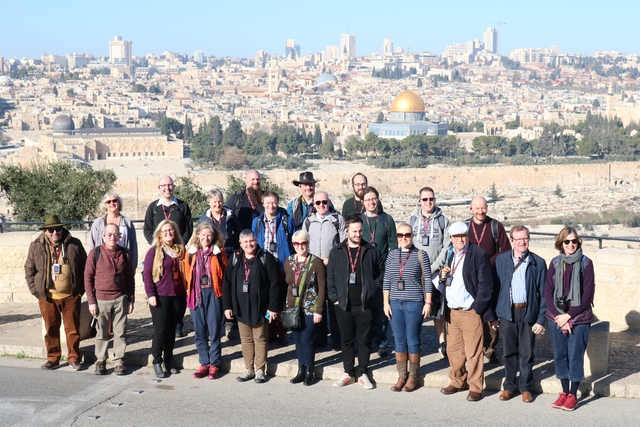
Watch the full half-hour video chronicling our curates' trip, day-by-day, or read the summary below:
IT was incredibly moving to see the places where Jesus was born, lived and died – and to understand the geography of the Bible better.
That’s what these Church of England clergy felt after a week in the Holy Land, visiting places like Jerusalem, Bethlehem, Nazareth and Galilee. Bishop Christopher led the pilgrimage to Israel and Palestine for 18 curates from across our diocese.
Among the highlights was the chance to sail across the Sea of Galilee, which Jesus would have done with his disciples. The calmness of the landscape contrasted massively with the hustle and bustle of modern-day Jerusalem.
In Jerusalem, they were able to touch the rock on which it is thought Jesus was crucified, and to see first-century burial chambers similar to those where Jesus was buried. They also renewed their baptismal vows in the River Jordan, at a spot similar to the one where John the Baptist baptised Jesus.
There was also a chance to understand better what people of other faiths believe. The curates saw Orthodox Jews praying at the Western Wall in Jerusalem, and visited the Jewish Holocaust Museum at Yad Vashem. They also donated gifts to children at a Bethlehem orphanage and visited the security wall between Israel and Palestine.
The Rev Sam Cullen, curate at St Peter’s Church, Petersfield, said: “There was something special about being on the Sea of Galilee and it being so still. It’s a beautiful lake and easy to experience God there, and to be filled with peace.
“It makes it all the more horrifying that Jesus left that beauty to go to Jerusalem, knowing that he would die there. It makes his sacrifice seem even greater.
“It showed us that we also have to follow Jesus from the comfortable, safe places to the uncomfortable, gritty places – that we shouldn’t be afraid of getting involved and helping those who are hurting and need compassion.”
And the Rev Matt Bray, curate at Harbour Church and Portsmouth Cathedral, said: “Being here made everything seem very real. We went into the dungeon under the High Priest’s house where Jesus would have been held after his arrest, and you could imagine Jesus being there.
“It will impact how I read the Bible and talk about faith. There is nothing more relevant to people than a God who knows what it is like to live as a human, as Jesus did.”
Scroll down to read the day-to-day experiences of our curates in more detail, and to see photos and videos.
Day 1: Jerusalem
Eighteen curates from across our diocese began their pilgrimage to the Holy Land with a day exploring the city of Jerusalem, led by Bishop Christopher and the Archdeacon of the Isle of Wight, the Ven Peter Sutton. It's an important part of their formation as curates to see and experience some of those things Jesus may have experienced, and to see the places where he lived, died and was buried.
The group started on the Mount of Olives, looking towards the east side of Jerusalem, where the old walled city is clearly visible over the Kidron Valley. They started at the Church of the Pater Noster, part of a Carmelite monastery and built to mark the spot where Jesus ascended to heaven. The cloister contains plaques with the Lord's Prayer written in more than 100 languages.
They then walked towards the valley, stopping at a chapel, Dominus Flevit, built to mark the place where Jesus cried over the city of Jerusalem. The group then went into the valley, to the Garden of Gethsemane, where Jesus prayed on the night before his crucifixion. This is a small olive grove, where some of the trees are thought to be 2,500 years old and therefore would have been there at he time Jesus was praying. The Biblical account says he prayed so fervently that he sweated drops of blood, yet was willing to go through the agony of the crucifixion.
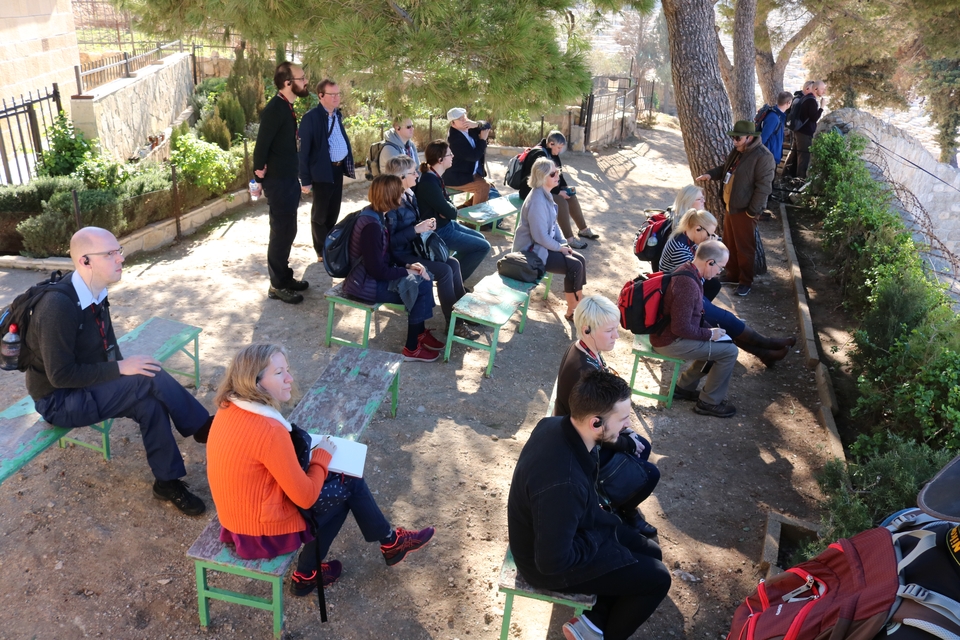
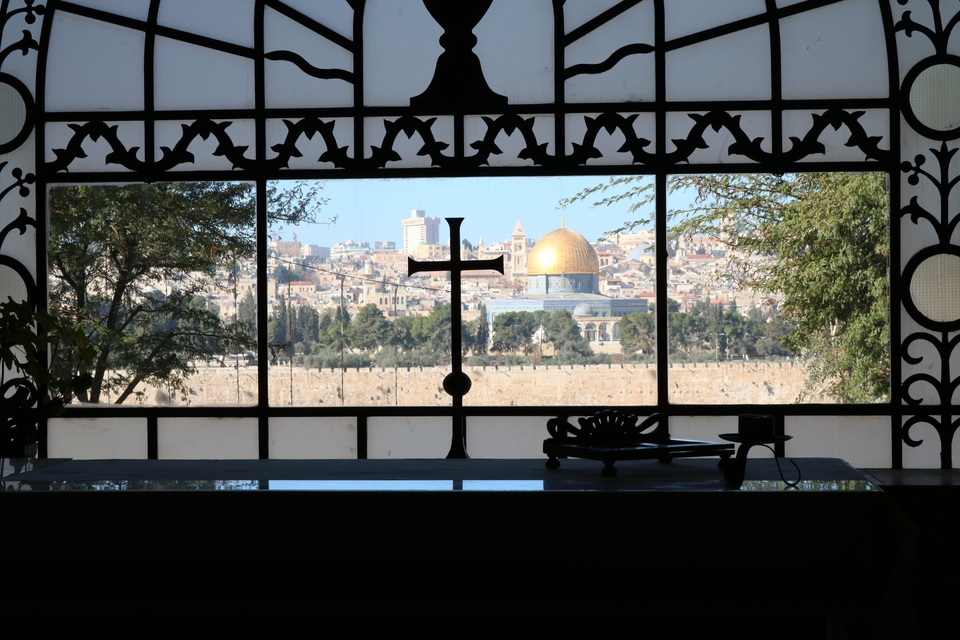
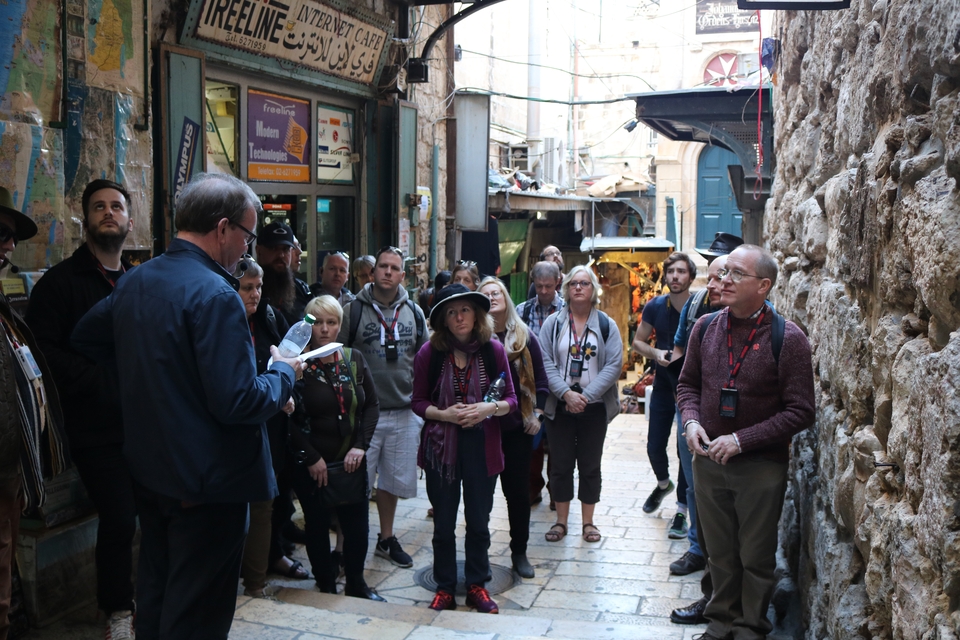
The curates then entered the walled city itself, visiting the Pool of Bethesda, where John's gospel records Jesus healed a man who had been crippled for many years. They celebrated Eucharist in the nearby visitors' centre before lunch in the Ecce Homo Convent. The convent was built on the site where it is thought Pontius Pilate presented Jesus, bound and crowned with thorns, to the hostile crowd, saying "Behold the Man".
In the afternoon, the curates walked the Via Dolorosa, the route Jesus is thought to have taken, carrying his cross, to his crucifixion. These days, the narrow lanes of the old city are thronged with tourists and shops selling merchandise, but it is possible to get a sense of what it might have looked like. Bishop Christopher led the curates on a reflection on the Stations of the Cross, ending in the Church of the Holy Sepulchre.
This remarkable building contains two of the holiest sites known in Christianity, according to traditions that go back to the fourth century. Inside the church, it is possible to see Calvary, the place of the skull, where Jesus was crucified. Under a Syrian Orthodox altar, pilgrims can touch the rock where Jesus's cross is thought to have stood.
Nearby is what may have been Jesus's tomb, enclosed in an 18th century shrine. Pilgrims queue patiently to go inside the shrine and to see the 'Holy Sepulchre', the tomb where Jesus's body may have been laid. Our curates chose to look instead at some similar first-century Jewish tombs nearby inside the church, which gave a good idea of what Jesus's tomb may have looked like.
There was much to take in and reflect on on the first day, not least the geography of Jerusalem, and the short distances between many of the places mentioned in the Biblical accounts. For more photos from Day 1 click here.
Day Two: West Jerusalem/Bethany
Our curates spent the morning understanding more about the history of Israel and the Jewish people. The first stop was Yad Vashem, the memorial to the Holocaust. It includes a moving Children's Memorial, which uses candles, mirrors and the names of children who died to help visitors understand the enormity of what happened. There's also a comprehensive Holocaust History Museum, which gives first-hand accounts of what happened to the Jewish people in Europe before, during and after the Second World War. It was a sobering and informative experience for our curates.
They then visited the Israel Museum, which includes a vast 1:50 scale model of Jerusalem in AD66, shortly after Jesus's time. It conveys the scale of the temple, compared to the rest of the city, and shows how the city walls changed over time. We were also able to see copies of some of the Dead Sea Scrolls - copies of the Hebrew Bible largely written in the first century AD. Until they were discovered in the 1940s, the oldest manuscripts we had dated from the 10th century. So this gave us copies of Biblical texts that were almost 1,000 years older than that - and yet largely identical to them.
After lunch at St Andrew's Church of Scotland guest house, our curates headed for Mount Zion and the possible site of the High Priest's house, from the Biblical account of Jesus's trial. This is now the Church of St Peter, Gallicantu, and is thought to be the place where the disciple Peter denied Jesus three times before the cock crowed (as Jesus predicted he would). The curates were able to see the steps where Jesus may have been dragged as he was taken to see Caiaphas, the High Priest. Below the church are dungeons, where Jesus may have spent that night.
We then drove out the village of Bethany, which is only a mile and a half from Jerusalem, but takes longer to get to these days because of the security wall. We visited a church on the spot where Jesus's friends Mary, Martha and Lazarus may have lived and visited a tomb which may have been Lazarus's before Jesus raised him from the dead.
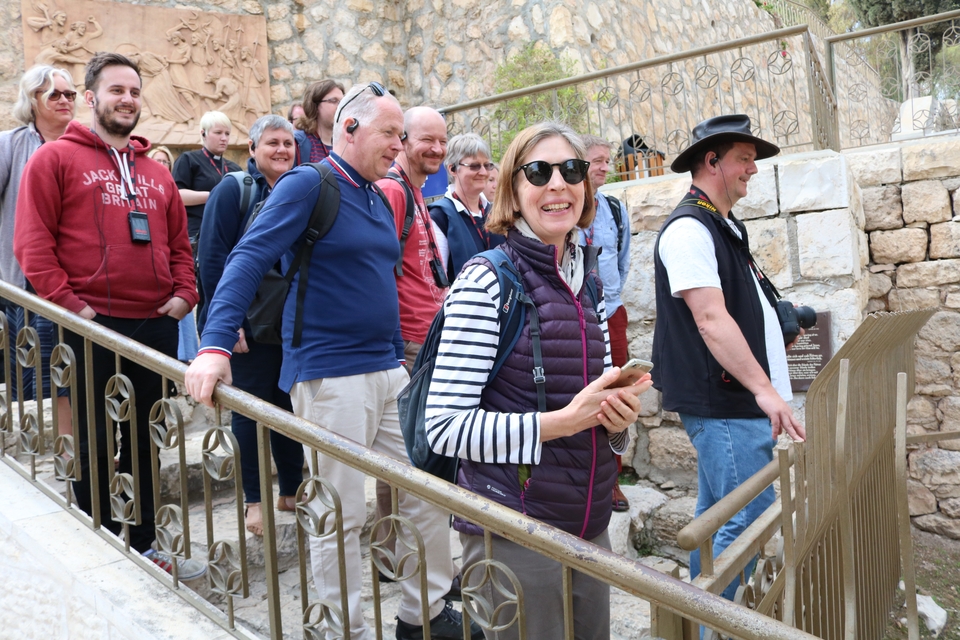

While we were in Bethany, we also called in at the Jeel al-Amal boys home, which is supported by McCabe Pilgrimages, who arranged the tour. It was founded in 1972 to care for orphans and now operates both as a home for 80 disadvantaged boys and as a school for 230 boys and girls from low-income families. Some of our curates had brought gifts for the home and some played football with some of the boys.
Our final stop, which came after dusk and as the Sabbath started, was to the Western Wall in Jerusalem. This is part of the limestone wall that used to surround the second Jewish Temple which existed in Jesus's time. The wall is the holiest place where Jews are permitted to pray. Our curates saw hundreds of Orthodox Jewish men dressed in long black silk coats and black top hats, reciting Jewish Scripture along the length of the wall. There was also a separate section for women to pray. For more photos from Day 2, click here.
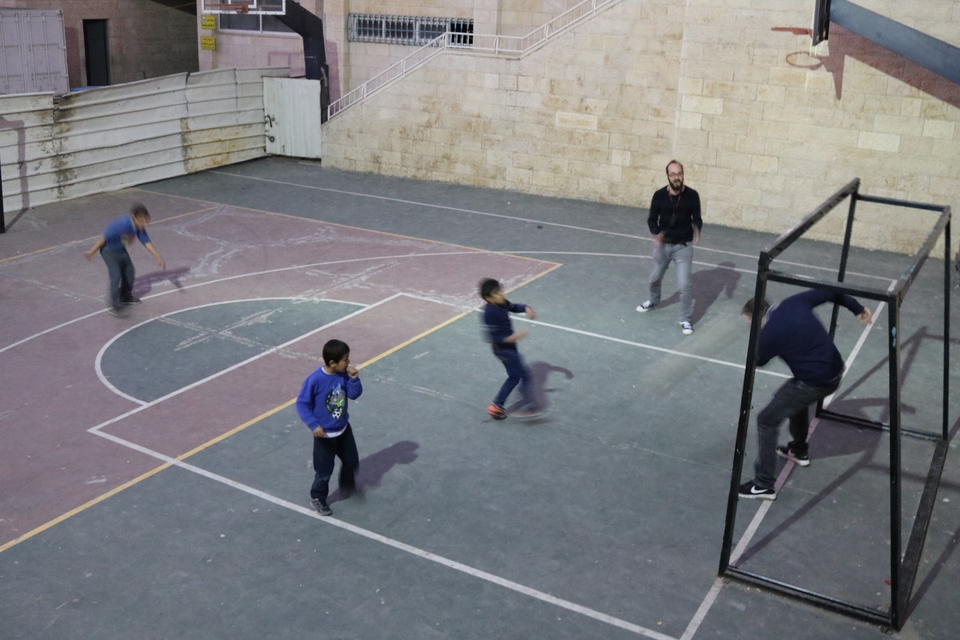
Day Three: Bethlehem and the West Bank
Our curates crossed into Palestinian territory for the third day of their pilgrimage in the Holy Land. They visited the Fields of the Shepherds, where it's thought the angels appeared to the shepherds to tell them about the birth of Jesus. After celebrating the Eucharist, they were able to look over the valley to similar hills. It was noticeable that the terrain would have might it hard to earn a living as a shepherd.
We went into Bethlehem itself to see the place where Jesus was born. We entered the Church of the Nativity, which is jointly run by Syrian Orthodox, Armenian and Roman Catholic denominations, and is one of the oldest churches in the world. Our curates went down to the Grotto of the Nativity below, and touched a star on the floor, which has been traditionally been thought of as the place Jesus was born.
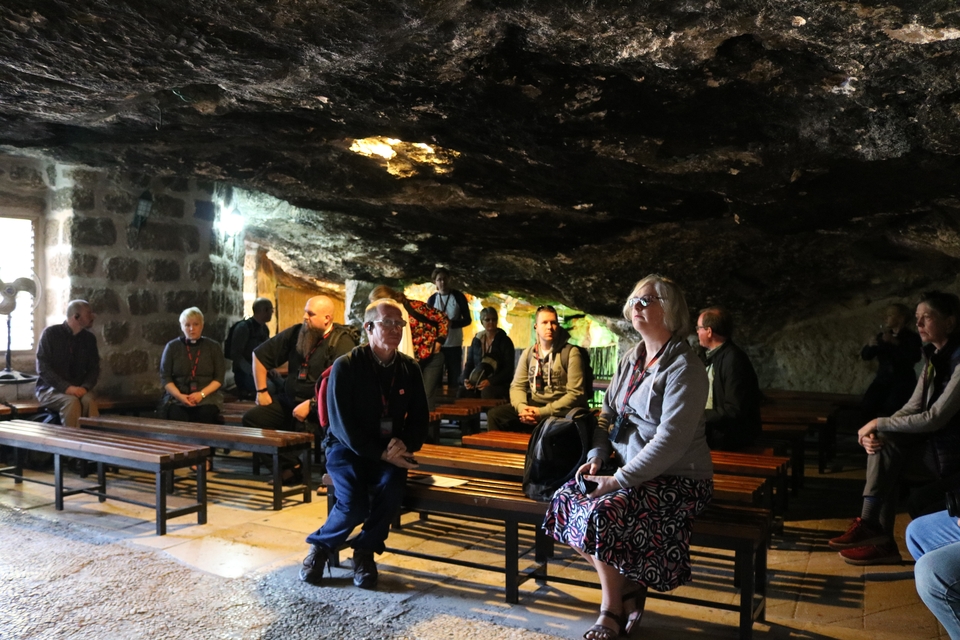
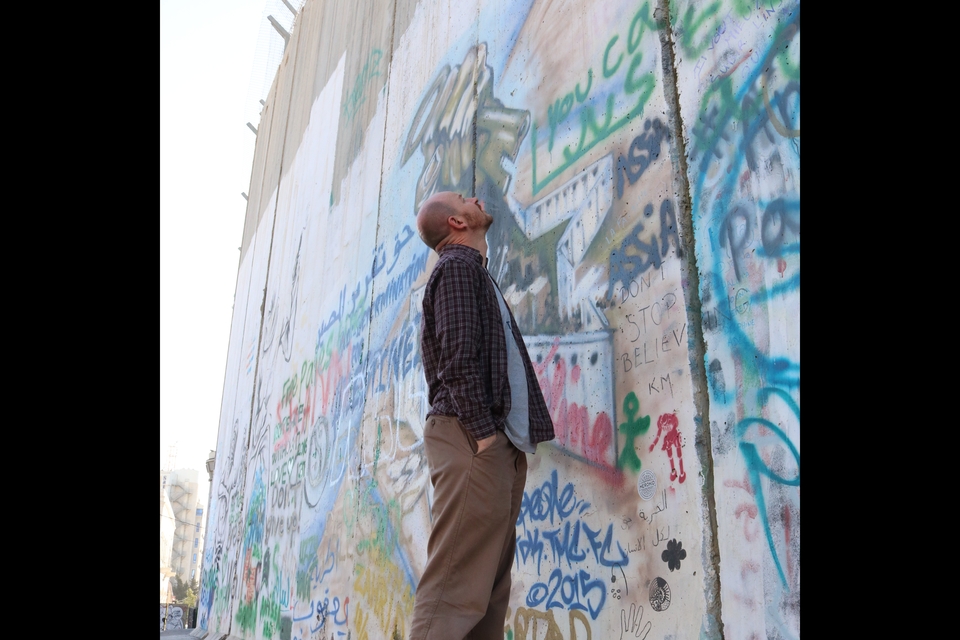
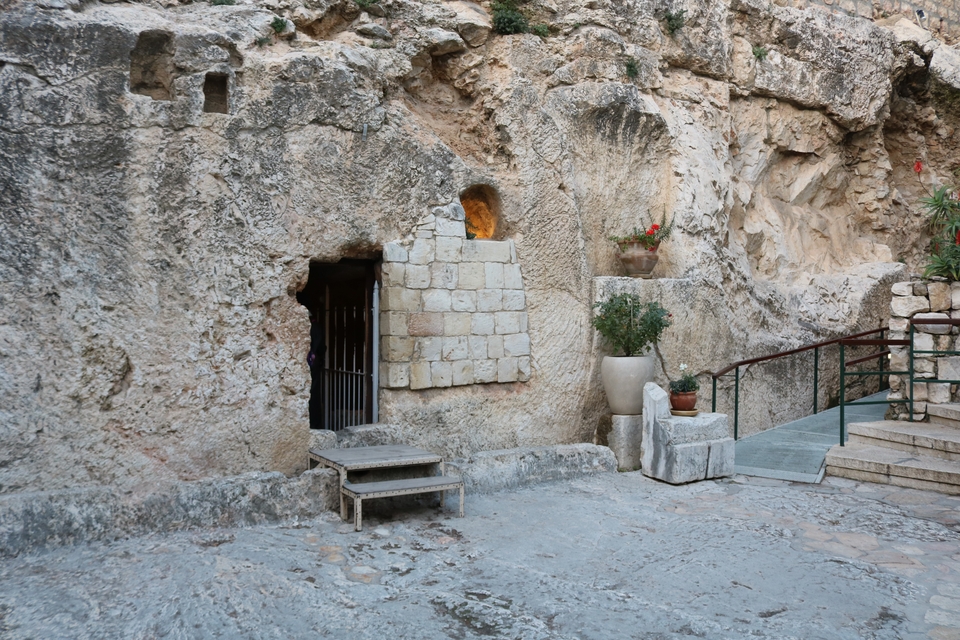
After lunch in the Shepherd's Tent, our curates were driven to the nearby security wall between Israel and the West Bank. In urban places, this is an eight-foot concrete wall, and in many places it has been adorned with political or creative graffiti. Our coach then headed back into Jerusalem, which meant crossing through the Israeli security barrier. Our wait was short and our entry was smooth, but our curates were able to reflect on the difficulty that many Palestinians have in crossing through the barrier each day to work or visit family and friends in Jerusalem.
Some of our curates were also able to visit the Garden Tomb in Jerusalem, which is a possible alternative place where Jesus was buried. This is a quiet garden location, where a family tomb carved out of the rock was unearthed in 1867. A nearby rocky escarpment may be an alternative location for Golgotha, the place where Jesus was crucified. For more photos from Day 3, click here.
Day Four: Jericho and the River Jordan
Our curates began Sunday at St George's Anglican Cathedral in Jerusalem, with local worshippers from many backgrounds. The service and sermon were in Arabic and English, meaning that at times the congregation were speaking or singing simultaneously in different languages - a great example of the global community of Christians.
We then started our drive north to Galilee, driving through the desert to the Wadi Qelt to see St George's monastery and to think about the desert nomads and modern-day Bedouins. We could also appreciate just how hilly and treacherous the Jericho to Jerusalem road must have been, and why Jesus chose this route for his Parable of the Good Samaritan.
We arrived in the desert oasis of Jericho, and saw an ancient sycamore tree that may have been similar to the one climbed by Zacchaeus in the gospel of Luke. We also saw the steep hill outside the city that may have been the one Jesus was standing on during his temptations in the desert. The Mount of Temptation has a Syrian Orthodox monastery clinging precariously on the side of it.
Our curates were then given the chance to renew their baptismal vows in the River Jordan, where John the Baptist would have baptised people in Jesus's time - including Jesus himself. Bishop's chaplain the Rev Richard Wyld waded into the river to lead us in the short service, after which many of the curates joined him. We then completely our journey to Tiberias, on the shores of the Sea of Galilee, where we'll be exploring some of Jesus's early life and ministry over future days. For more photos of Day 4, click here.
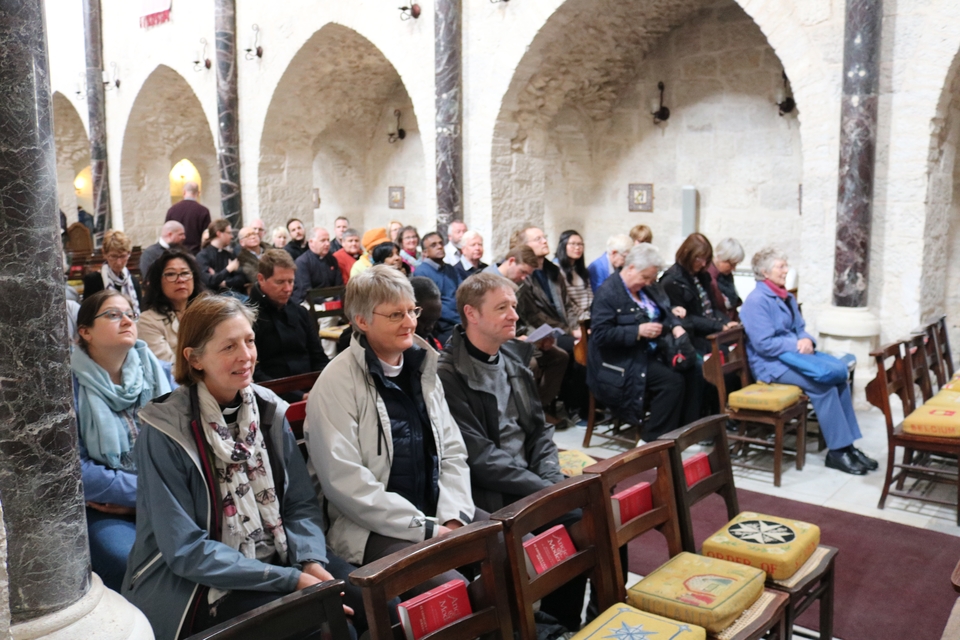
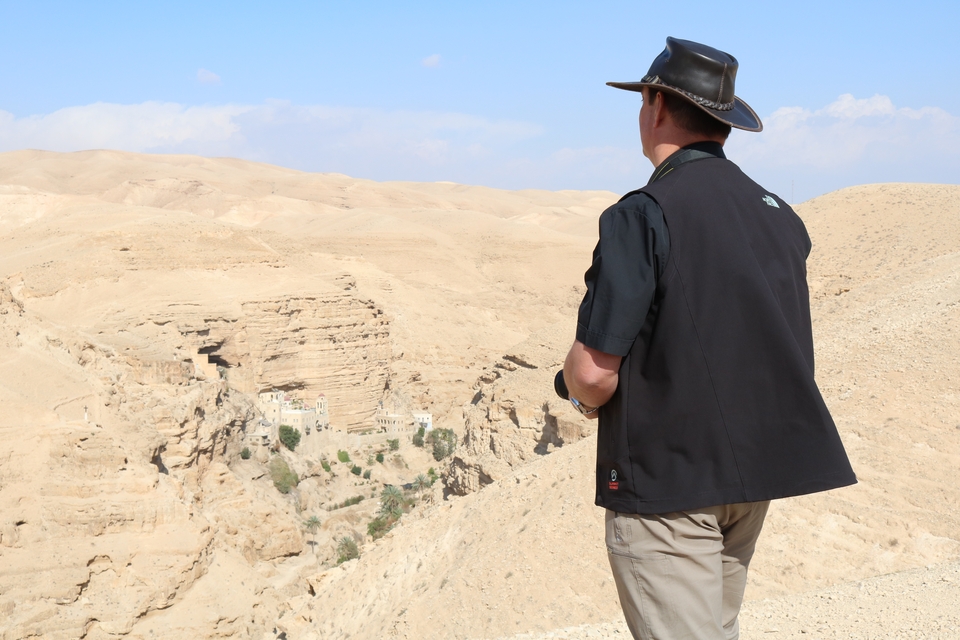
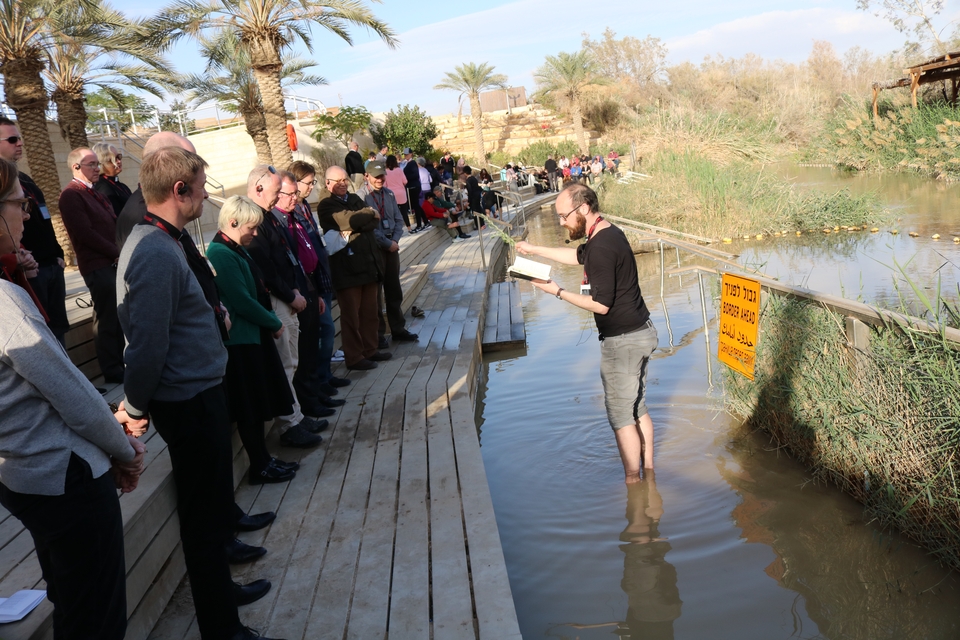
Day Five: Nazareth and Galilee
Our curates experienced some of the sights and sounds from the earlier years of Jesus's life around Galilee. They started at the top of Mount Tabor, which is thought to be the place where Jesus's transfiguration took place. This was the event recorded in three gospels, where his disciples saw him become radiant with light and appear to speak with Moses and Elijah. They saw the Basilica of the Transfiguration, a Franciscan church at the top of the mountain, which has three tabernacles, one for Moses, one for Elijah and one for Jesus. The view from the top of the mountain included looking at the Valley of Armageddon which the Book of Revelation suggests will be the place for the final battle between good and evil.
They then went to Nazareth itself, where Jesus grew up with Mary and Joseph. They went first to Mary's Well, a natural spring which it is thought existed in Jesus's time and from which Mary may well have drawn water. It is now inside a church, the Greek Orthodox Church of the Annunciation, and according to some traditions, this is where the angel Gabriel told Mary she was to give birth to Jesus.
Our curates then went to Nazareth Village, a recreation of what the village might have looked like in Jesus's time. It includes a recreation of a first-century house, and actors dressed in authentic costumes explaining what tools Joseph might have used in his carpentry trade, and how wool was spun and woven to create clothes. There is also a a replica of a first-century synagogue, similar to the one that Jesus would have worshipped in. It was in the Nazareth synagogue that Jesus declared his mission, as encapsulated in Isaiah 61.

We also went to the Basilica of the Annunciation, which is the Catholic church built on the spot where Mary lived and where the angel may have told he she would become pregnant. It includes a gallery of large images of Mary made by Christians from across the world.
And our curates ended up at Cana, the place where Jesus performed his first miracle - turning water into wine at a wedding. We saw an ancient clay pot, which dates back to the time of Jesus, similar to those that would have been used on such an occasion. We also got the chance to try some samples of Cana wine. Back in Tiberias, some of our curates then swam in the Sea of Galilee. For more photos from Day 5, click here.
Day Six: Sea of Galilee
Our curates were able to reflect on Jesus's lakeside ministry on their penultimate day in the Holy Land. They started on the shores of the Sea of Galilee at the spot where the risen Jesus reinstated the disciple Peter. The Bible tell us that Peter and the disciples were fishing on the lake when they saw the risen Jesus cooking them fish for breakfast. Peter leapt out of the boat and splashed ashore. Having denied Jesus three times before his death, he now declared his devotion three times. The Franciscan Church of the Primacy of Peter was built here to denote how Jesus's church was begun by Peter from that day.
We continued to the ruins of Capernaum, a fishing village where Jesus based much of his early ministry. The arrangement of walls showed us how inter-connected people's homes were in first-century Palestine. The ruins of a synagogue - albeit from the third century - showed us how townspeople worshipped. And one of the houses is believed to be that of Simon Peter's mother-in-law, who Jesus healed of a fever.
Bishop Christopher celebrated the Eucharist on the shores of Galilee, in a place called Tabgha, where Jesus is thought to have fed 5,000 men as well as women and children. The Catholic Church of the Multiplication has been established there. We found a spot outside, close to the water's edge, where the bishop led us gently through Communion as we gazed over the calm water.
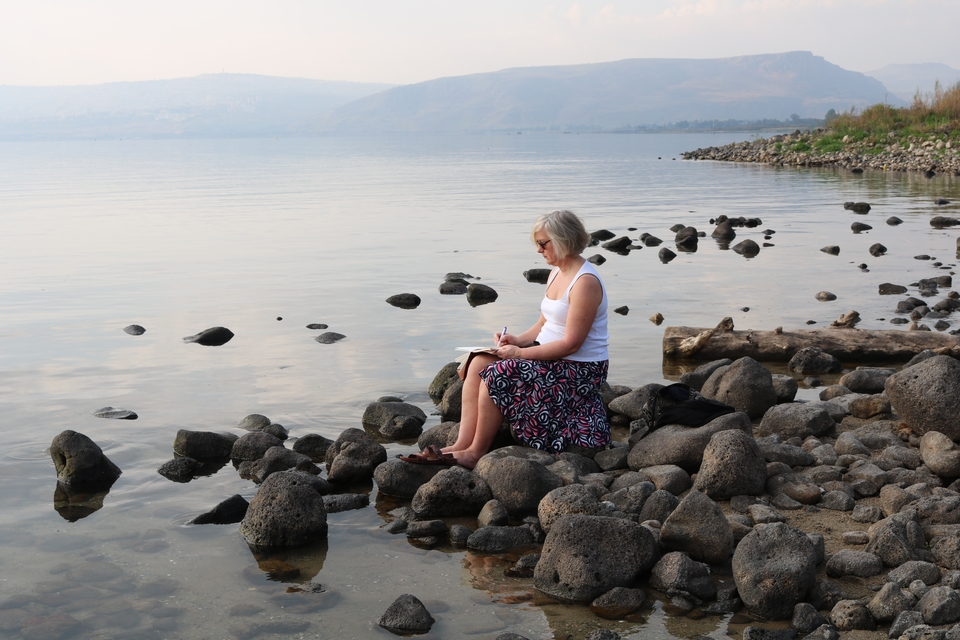
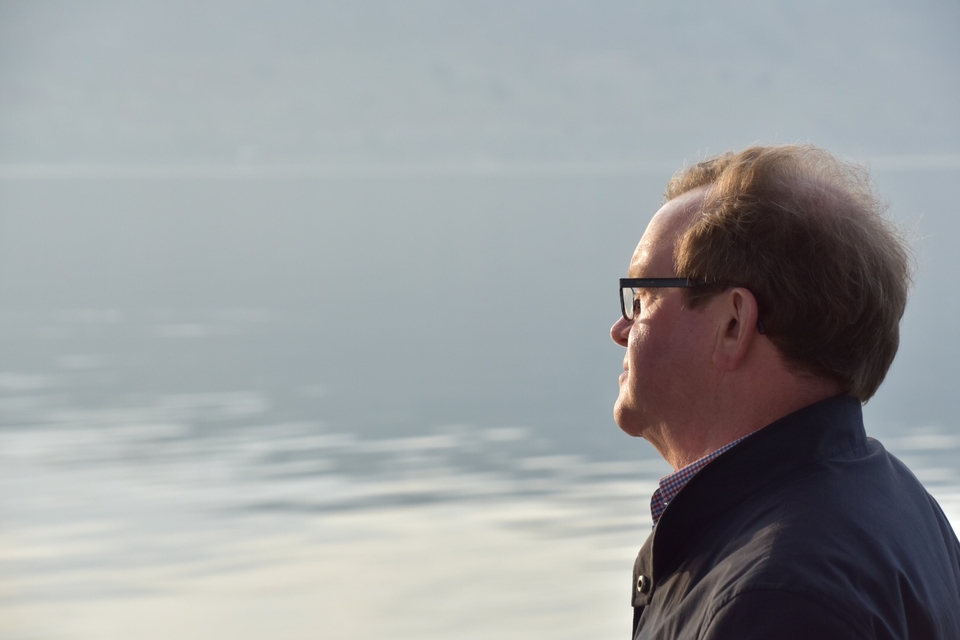
Our curates enjoyed lunch on the Mount of Beatitudes, the hill where Jesus is thought to have spoken the famous words at the start of the Sermon on the Mount. We ate grilled fish, similar to the fish that Jesus cooked his disciples for breakfast. There is now a convent on the top of the hill, with beautiful gardens. Verses from the Beatitudes are scattered around the garden to help visitors meditate on Jesus's words.
Our group then sailed back across the Sea of Galilee from Capernaum to Tiberias. The calmness of the water means that voices travel much further. It's possible to imagine Jesus preaching from a boat and for thousands of people to hear him. In the middle of the lake, we cut the engine and enjoyed the silence. Bishop Christopher led us in a reflection about our calling, and we sang Dear Lord and Father of Mankind together. It was a poignant moment.
For more photos from Day 6, click here.
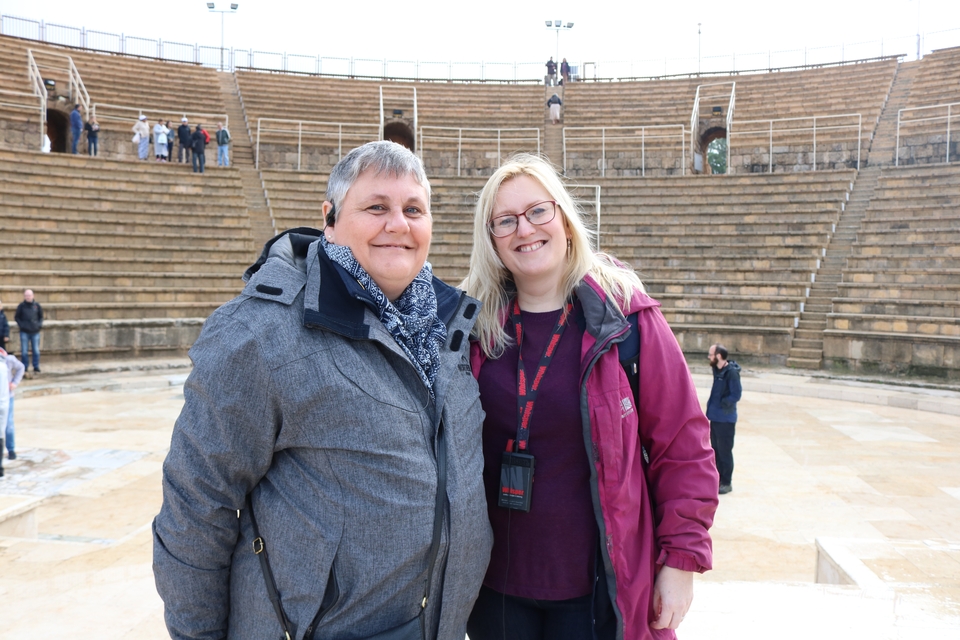
Day Seven: Caesarea
On the final day of our curates' pilgrimage, we visited the Roman capital of Caesarea, on the Mediterranean coast. This impressive city was built by Herod the Great just before Jesus's time, and served as the capital of the Roman province of Judea. Among other things, our curates saw its amphitheatre, its aqueduct, and its hippodrome where Roman chariots raced. Seeing the historical evidence for the rule of Pontius Pilate and others puts the story of Jesus into its historical context.
For more photos from Day 7, click here.